Firefighting Aircraft Market Research, 2032
The global firefighting aircraft market size was valued at $9 billion in 2022, and is projected to reach $16.2 billion by 2032, growing at a CAGR of 6.3% from 2023 to 2032. Firefighting aircraft are aircraft that are used to help get large fires under control. Firefighting aircraft and helicopters help fight forest fires quickly and effectively. There are two types of firefighting aircraft, fixed-wing, and rotorcraft.
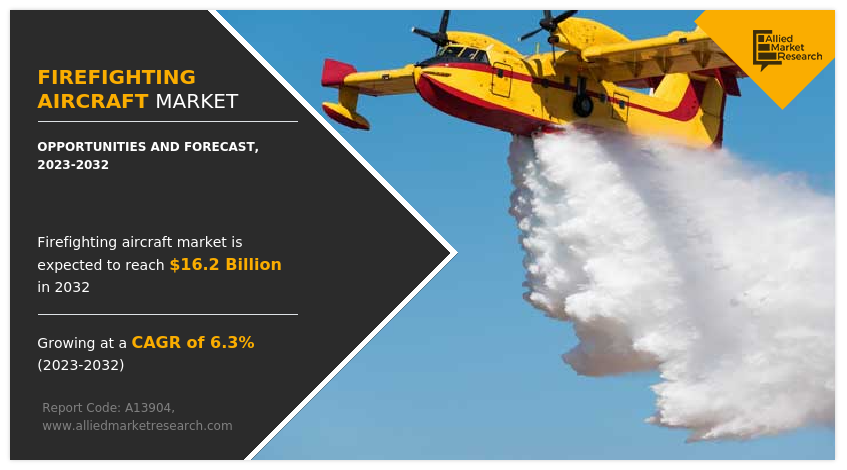
Report Key Highlighters:
- The firefighting aircraft market studies more than 15 countries. The analysis includes a country-by-country breakdown analysis in terms of value ($ million) available over the forecast period 2022-2032.
- The research combined high-quality data, professional opinion, and research, with significant independent opinion. The research methodology aims to provide a balanced view of the global market and help stakeholders make educated decisions to achieve ambitious growth objectives.
- The research reviewed more than 3,700 product catalogs, annual reports, industry descriptions, and other comparable resources from leading industry players to gain a better understanding of the firefighting aircraft market.
- The firefighting aircraft market share is marginally fragmented, with players such as Lockheed Martin Corporation, Bombardier Inc., Airbus SE, Kaman Corporation, Coulson Group, Viking Air Ltd., Saab AB, ShinMaywa Industries, Ltd., Conair Aerial Firefighting, and Textron Inc. Major strategies such as contracts, agreements, partnerships, expansion, and other strategies of players operating in the market are tracked and monitored.
An airtanker is a fixed-wing aircraft that can carry fire retardant or water and drop it on or in front of a fire to slow the fire down. Some popular airtankers are C-130 HERCULES, LM-100J FireHerc, C-130J Super Hercules, CL-415, and others. A helicopter is a rotary-wing aircraft that is attached with a tank to carry water or fire retardant. The tanks or buckets can be filled on the ground by drawing water from lakes, rivers, or other water sources.
Rise in the frequency and severity of wildfires, increase in government investment and funding, environmental awareness and climate change impact are factors that drive the firefighting aircraft market. However, high acquisition and operational costs, and limited availability of specialized aircraft hinder the growth of the market. Furthermore, technological advancements in aerial firefighting systems, coupled with R&DR&D of sustainable fire retardants provide remarkable growth opportunities for the players operating in the market.
The firefighting aircraft market is segmented on the basis of aircraft type, tank capacity, maximum takeoff weight, range, and region. On the basis of aircraft type, the market is bifurcated into fixed-wing, and rotorcraft.
On the basis of tank capacity, it is categorized into less than 10,000 liters, 10,000 to 30,000 liters, and more than 30,000 liters. On the basis of maximum takeoff weight, the market is classified into less than 8,000 kg, 8,000 to 30,000 kg, and more than 30,000 kg. On the basis of range, the it is divided into less than 1,000 km, 1,000 to 3,000 km, and more than 3,000 km. On the basis of region, the market is analyzed in North America, Europe, Asia Pacific, and LAMEA.
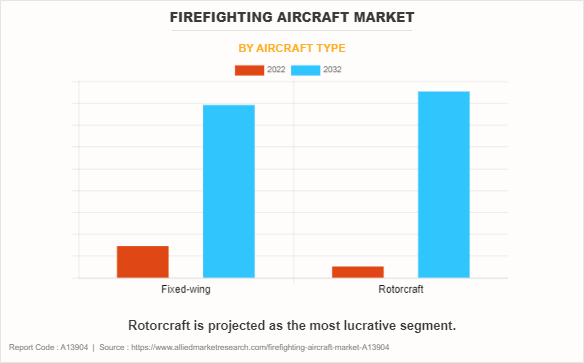
The world has witnessed a rise in the occurrence and intensity of wildfires, attributed to factors such as climate change, prolonged periods of drought, and alterations in land-use patterns. Consequently, there is an increased need for state-of-the-art firefighting aircraft to more effectively address the challenges posed by wildfires. There is an increase in the deployment and availability of firefighting aircraft in response to the evolving wildfire landscape.
For instance, in July 2023, Governor of California, the U.S., Gavin Newsom announced the allocation of over $72 million in funding to CAL FIRE. CAL FIRE plans to use the allocated funds to expand its firefighting aircraft fleet for the second consecutive year. Such developments represent a substantial financial commitment to enhancing firefighting capabilities. Such investments are a key driver for the firefighting aircraft market, as they enable firefighting agencies to acquire, maintain, and deploy a more extensive and advanced fleet.
Rise in the Frequency and Severity of Wildfires
The rise in the frequency and severity of wildfires serves as a critical driver for the demand and utilization of firefighting aircraft. Prolonged droughts, and evolving land-use patterns contribute to an increased occurrence and intensity of wildfires as climate changes.
For instance, a report from the UN Environment Programme (UNEP) and GRID-Arendal highlights the increase in threat of wildfires globally due to climate change and land-use changes. The report projects a rise in the frequency and intensity of wildfires globally. It indicates that extreme fires could increase by up to 14% by 2030, 30% by the end of 2050, and 50% by the end of the century. This projection is attributed to the combined impacts of climate change and alterations in land use. traditional firefighting methods may become insufficient to contain and control these incidents effectively.
Firefighting aircraft, equipped with advanced technologies and capabilities, play a pivotal role in addressing the challenges posed by more frequent and severe wildfires. These aircraft can provide rapid response, strategic aerial firefighting, and precision targeting of fire-prone areas.
The heightened demand for firefighting aircraft is a direct response to the growing urgency and complexity of wildfires, positioning these aerial assets as essential tools in mitigating the impact of these natural disasters. The need for sophisticated firefighting aircraft has become increasingly apparent, driving investments and advancements in this sector as the wildfire landscape evolves.
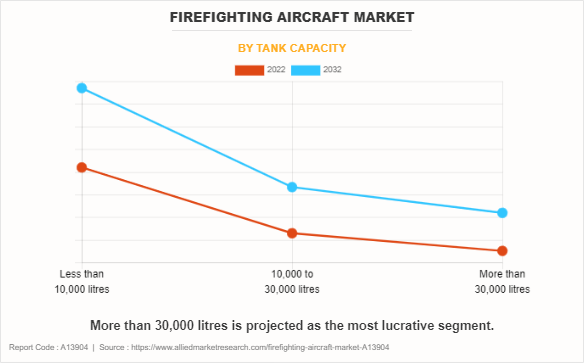
Increase in Government Investment and Funding
The increase in government investment and funding serves as a significant driver for the firefighting aircraft market. Governments recognize the urgent need to enhance firefighting capabilities to protect lives, property, and natural resources as the frequency and severity of wildfires grow. In response to this, there is a notable trend of governments allocating substantial financial resources to bolster firefighting infrastructure.
Government investment facilitates the acquisition, maintenance, and modernization of firefighting aircraft fleets. For instance, in November 2023, Minister for Agriculture, Rural Development and Environment European Union set a state budget which allocates $12.5 million for leasing or purchasing two firefighting helicopters and the services of four firefighting planes. Such funding or investment supports the procurement of advanced aerial firefighting technologies, such as specialized aircraft, helicopters, and water-bombing planes, equipped with state-of-the-art firefighting systems. In addition, investments often contribute to R&D efforts focused on improving the efficiency and sustainability of firefighting operations, which is expected to drive the firefighting aircraft market growth.
High Acquisition and Operational Cost
Acquiring firefighting aircraft, such as air tankers and specialized helicopters, comes with considerable upfront expenses. Moreover, operational costs covering maintenance, fuel, and personnel add to the overall financial burden. These high costs pose a substantial challenge for firefighting agencies, particularly those working with limited budgets. Securing and sustaining a sufficient fleet of firefighting aircraft becomes difficult, potentially leading to delayed or restricted responses to wildfire incidents. This financial constraint significantly hampers the overall effectiveness of firefighting operations.
Limited Availability of Specialized Aircraft
The firefighting aircraft market trends highlight specially designed firefighting aircraft that are quite specialized, and there are not many options available with the unique features needed for aerial firefighting operations. This scarcity is due to these aircraft require specific capabilities. This shortage presents a challenge for firefighting agencies as they struggle to swiftly obtain the necessary resources, especially during the peak wildfire seasons. The competition for these aircraft among various regions or countries is expected to worsen the situation, leading to potential delays in securing crucial assets.
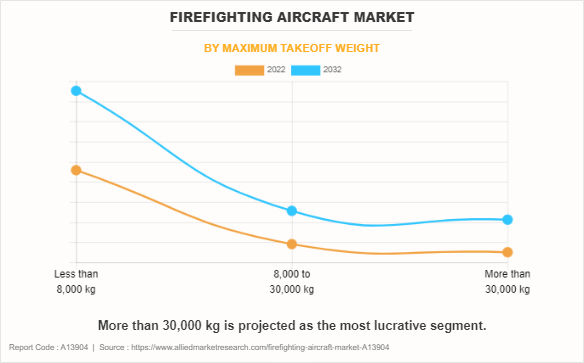
Impact of Russia-Ukraine War on Firefighting Aircraft Industry
On February 24, 2022, Russia invaded Ukraine, leading to the Russo-Ukrainian war that began in 2014. They often bring about global economic uncertainties. In times of economic unpredictability, government budgets may be affected, potentially influencing the allocation of funds for firefighting endeavors. This, in turn, could impact the procurement and upkeep of firefighting aircraft.
Furthermore, geopolitical events have the potential to disrupt global supply chains. If crucial components or technologies for firefighting aircraft are sourced from regions directly affected by the conflict, it may result in delays in manufacturing and delivery, ultimately affecting the overall availability of firefighting aircraft.
Moreover, the firefighting aircraft industry has been adversely affected by the conflict between Russia and Ukraine, mainly because of supply chain disruptions involving essential raw materials. The supply chain of Russia, a significant manufacturer of titanium, a substance that is frequently used in the aerospace industry due to its strength and low weight, especially in widebody aircraft, has been impacted. It has been difficult for the big aircraft manufacturers, such as Boeing and Airbus SE, to get a steady supply of titanium.
Recent Developments in the Firefighting Aircraft Industry
- In August 2021, Lockheed Martin received a contract from United Rotorcraft to provide five S-70 Black Hawk helicopters. The purpose of these aircraft is to support aerial firefighting operations conducted by public agencies, especially in the face of escalating and destructive wildland fires.
- In October 2022, Kaman Corporation received a signed purchase agreement from North American Helicopter for a K-MAX medium-to-heavy lift helicopter.
- In May 2022, Kaman Corporation officially announced its plan to acquire Aircraft Wheel & Brake division of Parker-Hannifin Corporation. The acquisition is valued at $440 million.
- In August 2023, Coulson Aviation was selected as one of five organizations to receive an indefinite delivery/indefinite-quantity contract. This contract encompasses operations utilizing C-130H Hercules and Boeing 737 Fireliner aircraft of Coulson, and providing maintenance support.
- In November 2023, Coulson Aviation secured a $16 million firefighting contract to extend its support for Quick Reaction Force (QRF) of Southern California throughout the entirety of 2024, with the possibility of extending the contract into 2025. Under this contract, Coulson Aviation is expected to provide three Boeing CH-47 Chinook helitankers, a Sikorsky S-76 intelligence and reconnaissance helicopter, along with the necessary flight and maintenance crews.
- In November 2023, Coulson Aviation secured a three-year firefighting contract with Corporación Nacional Forestal (CONAF) of Chile. The contract entails the deployment of a C-130H Hercules Large AirTanker and a Citation 550 air attack lead plane.
- In July 2022, Coulson Aviation introduced its latest aircraft, an aerial firefighting tanker converted from a Boeing 737.
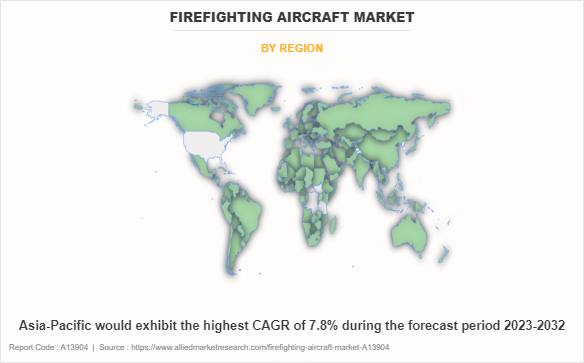
Key Benefits For Stakeholders
This report provides a quantitative analysis of the market segments, current trends, estimations, and dynamics of the firefighting aircraft market analysis from 2022 to 2032 to identify the prevailing market opportunities.
The market research is offered along with information related to key drivers, restraints, and opportunities.
- Porter's five forces analysis highlights the potency of buyers and suppliers to enable stakeholders make profit-oriented business decisions and strengthen their supplier-buyer network.
- In-depth analysis of the market segmentation assists to determine the prevailing market opportunities.
- Major countries in each region are mapped according to their revenue contribution to the global firefighting aircraftmarket.
- Market player positioning facilitates benchmarking and provides a clear understanding of the present position of the market players.
- The report includes the analysis of the regional as well as global market trends, key players, market segments, application areas, and market growth strategies.
Firefighting Aircraft Market Report Highlights
| Aspects | Details |
| Market Size By 2032 | USD 16.2 billion |
| Growth Rate | CAGR of 6.3% |
| Forecast period | 2022 - 2032 |
| Report Pages | 250 |
| By Aircraft Type |
|
| By Tank Capacity |
|
| By Maximum Takeoff Weight |
|
| By Range |
|
| By Region |
|
| Key Market Players | Saab AB, Kaman Corporation., Viking Air Ltd, Textron, Inc, ShinMaywa Industries, Ltd., Bombardier Inc., Conair Aerial Firefighting, Airbus, Lockheed Martin Corporation, COULSON GROUP |
The global firefighting aircraft market was valued at $8,992.0 million in 2022, and is projected to reach $16,218.6 million by 2032, registering a CAGR of 6.3% from 2023 to 2032.
The firefighting aircraft market share is marginally fragmented, with players such as Lockheed Martin Corporation, Bombardier Inc., Airbus SE, Kaman Corporation, Coulson Group, Viking Air Ltd., Saab AB, ShinMaywa Industries, Ltd., Conair Aerial Firefighting, and Textron Inc.
The largest regional market for firefighting aircraft is North America.
The leading aircraft type of firefighting aircraft market are fixed wing.
The upcoming trends of firefighting aircraft market in the world are technological advancements in aerial firefighting systems, coupled with R&D of sustainable fire retardants.
Loading Table Of Content...
Loading Research Methodology...



